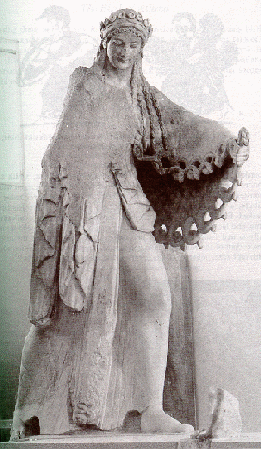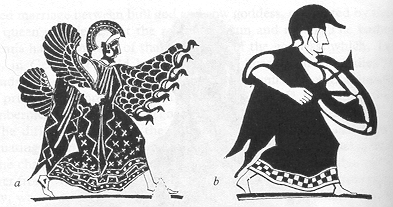Early Athena

Athena. Ca. 520 BCE.
From the Gigantomachy Pediment in the Archaic temple on the Acropolis
In classical Greek art there are two quite different images of the Athena. The more familiar figure is the severe, helmeted and girdled goddess, with firm stride and massive shield, the unvanquished virgin warrior as guardian all of the city, she who "cares for the work of war, the destruction of cities and the shouts of battle". However, there is an older image of a wild and awesome goddess, wreathed in snakes, where snakes wind around her head as hair and crown, their heads fringe the folds of her robe, and she holds a rearing head firmly in her left hand. The two images are usually alternative conceptions of the goddess, but are found together as two sides of one cup.

a. Shows Athena winged, with a snake-robe; and b. Athena with shield; painted figures on two sides of black-figured cup.
But even when the goddess as warrior is found on her own, she still carries the archaic memory of her origins in the design of her shield -- the head of the Gorgon hissing with snakes, also known as the aegis, the goatskin. (...) Either way, the gorgon's head remains a testament to an earlier time, and looking through the classical myth of the daughter who sprang fully armed from the head of her father, Zeus, we can see the direct descendant of the Minoan snake goddess of over 1,000 years earlier, who, with rapt gaze, held the snakes of life and death in both her hands.

Athena with snake, shield, swastikas and gorgon's head; vase painting by the Andokides painter, ca. 525 BCE
Images and Text taken from
The Myth of the Goddess: Evolution of an Image
Anne Baring and Jules Cashford, Arkana, 1991.
(For Educational Purposes Only)
Last Updated: November 22, 2001

All Content Here and on Linked Pages COPYRIGHT 1997 - 2001 All Rights Reserved

GRIFFIS CONSULTING
Contact the webmistress for any problems in connecting links with this site




